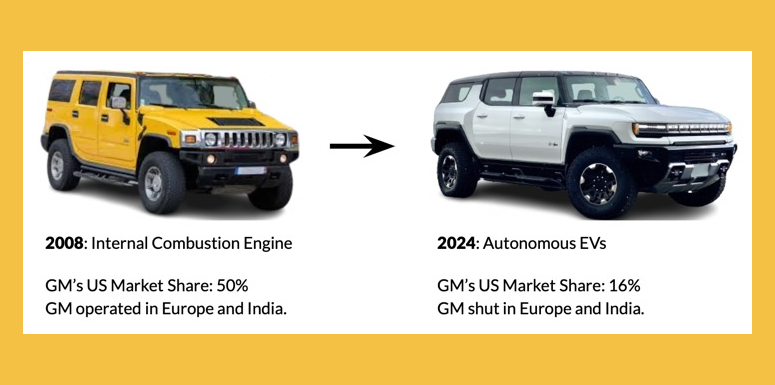
What is the ‘Media Flywheels’ Newsletter

Originally published on The Times of India.
In a May 2024 interview with Bloomberg, General Motors CEO Mary Barra emphasized the urgent need for change, stating, “You can’t continue doing what hasn’t been working.” Barra acknowledged that despite GM’s century-long history, the company has no inherent right to exist. This lesson was underscored by the aftermath of the 2008 financial crisis and Tesla’s launch of its first electric vehicle (EV), the Roadster. In the 15 years since, GM’s market share in the US car industry plummeted from 50% to roughly 16% in 2023 and GM had to exit the Europe and India market.
Bloomberg’s David Welch, a veteran auto industry analyst, noted that while Mary Barra’s vision of rapidly expanding GM’s EV offerings across all segments is a sound strategy, it’s unlikely to be achieved. The transition to electric vehicles is far more challenging than anticipated, and GM lacks expertise in key technologies like batteries, software, and AI.
Media’s Predicament
Media companies find themselves in a similar predicament. To remain relevant and profitable in an increasingly competitive and technologically advanced market, they too must overhaul their strategies and operations.
Over the past two decades, the consumption of news, media, and advertising has shifted dramatically from traditional digital platforms to algorithmic marketplaces – search engines, social media, over-the-top (OTT) services, and now AI chatbots like ChatGPT.

This shift has vastly improved information accessibility, benefiting billions of people. However, it has also posed challenges for media companies to reassess and evolve their value propositions, leveraging their strengths in news gathering, verification, and ethical judgment.
This rapidly changing environment presents complex challenges for media executives as they strive to balance innovation with traditional media values while ensuring sustainable cash flow.

At the Crossroads
Media companies increasingly face a stark choice: take back control of supply-and-demand variables or become suppliers to algorithmic marketplaces.
Few, large media companies will try regaining strategic control by investing to become a compute-heavy direct-to-consumer (D2C) algorithmic media platforms themselves. This transformation is akin to a car company shifting from internal combustion engines to autonomous electric vehicles. It requires a complete overhaul of products, processes, and teams, not just superficial changes. Anything less will be insufficient.
Few other media companies will become compute-light D2C media products. They will be disciplined to retain control over core supply and demand business functions. They will likely build a loyal audience on their newsletters and mobile apps, even if it comes at a cost of scale.
Most media companies may find opportunities as content creators on algorithmic marketplaces—search engines, social, ChatGPT, etc. By strategically focusing on core strengths and community-oriented models, these companies can achieve financial sustainability and retain a loyal audience. However, they will have to streamline technology, product, and business functions for great efficiency and focus.
Considering how divergent these choices are, it becomes critical to build a coherent strategy to develop strategic assets and healthy annual cash flows.
Navigating Uncertainty
‘Media Flywheels’ aims to provide a coherent, consistent and clear assessment of the state of the digital news and media industry in terms of its profitability and its function as a vital, trusted cornerstone of civic life. This newsletter is structured around three key pillars:
1. Reality Check
The digital news and media industry is almost 30 years old now. Years ago, decisions were made based on the market and technology situation of their time. Once the business stabilized, inertia set in, and companies hesitated to change what worked. But over time, the decisions became outdated because the original assumptions no longer hold true.
Now many of those decisions have transformed into a wicked problem—a complex web of interconnected challenges where multiple factors must be addressed simultaneously to achieve meaningful change.
Much like an astronaut gazing upon the Earth from space gains a new perspective on our planet’s fragility and interconnectedness, these sections step back from the familiar everyday and zoom out to a 30,000-foot view.
While these sections can feel overly pessimistic, they ground our understanding in the present realities. Without questioning current assumptions, AI will only amplify existing failures.
2. Guiding Policy
These sections try to define frameworks to understand the fundamentals of the media business amidst disruption. These fundamentals should hold true 10 years from now. The reality check will showcase the anchors holding you back, and the guiding policy will act like a tugboat pulling you forward.

3. Solutions
A common theme across most of Nieman Lab’s annual journalism predictions series is pervasive pessimism, even cynicism, regarding the current state of affairs, accompanied by calls for innovation, user-centricity, community focus, and the like. However, this isn’t merely a matter of discipline or focus; it’s about reclaiming control.
The hope is that the previous sections will help replace uncertainty, complexity, and ambiguity with understanding, clarity, and agility. By leveraging the strengths of algorithmic platforms alongside traditional media values, we can achieve a clearer vision for the future and shift the Overton window from ‘implausible’ to ‘plausible.
Calling for Co-builders
To be truly effective and eliminate confirmation bias, any proposed solution must address all aspects of the media business. I am looking to collaborate with experts from various functions – editorial, affiliate marketing, programmatic advertising, direct sales, and others.
Together, we can identify blind spots, innovate new solutions, and strengthen the fundamentals of their respective areas. Together, we can articulate a vision for the future of digital news and media. Interested in collaborating? Reach out and let’s brainstorm the future of media together.

Finally, digital news and media is a constantly evolving industry. This newsletter is written as a collection of “working notes” that will be regularly updated.
–
Want to republish it? This post was released under CC BY-ND — you can republish it as is with the following credit and backlinks: ‘Originally published by Ritvvij Parrikh on The Times of India. The author retains the copyright and any other ancillary rights to the post.
